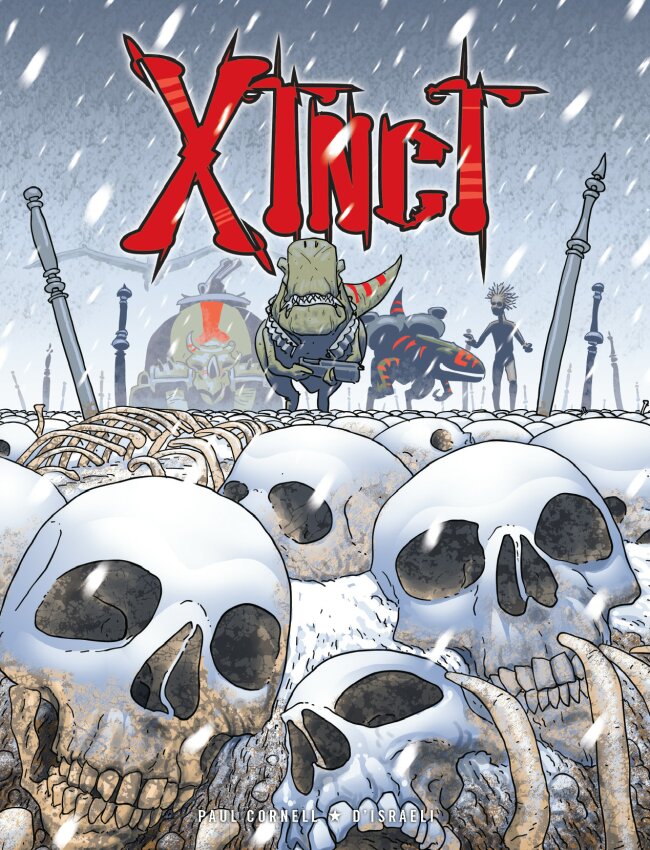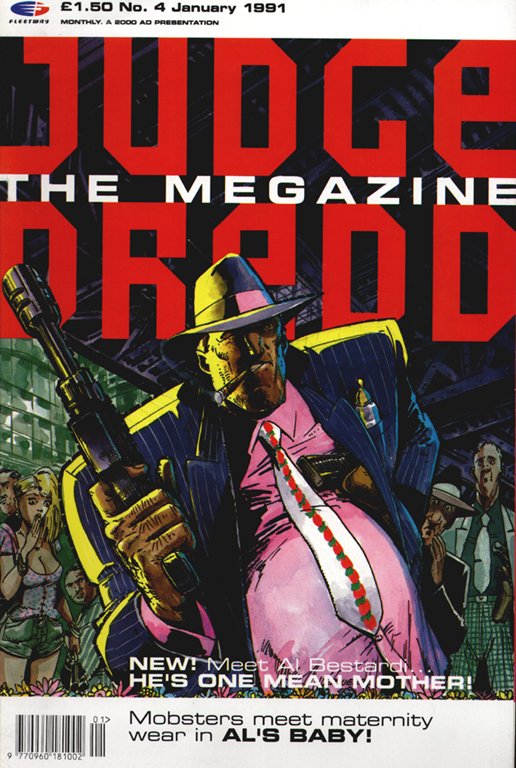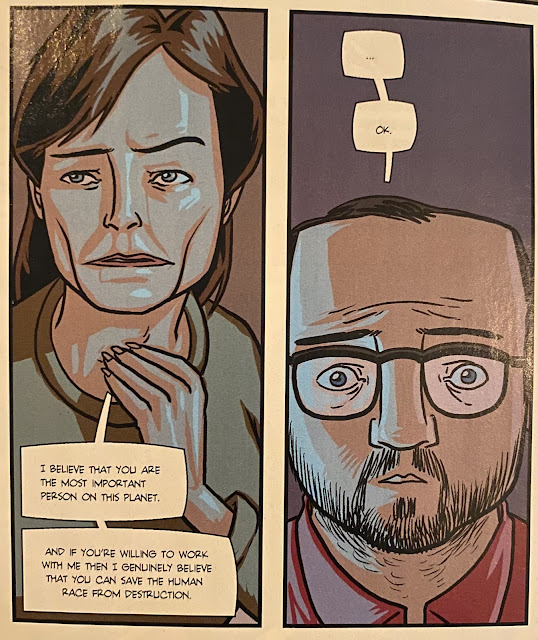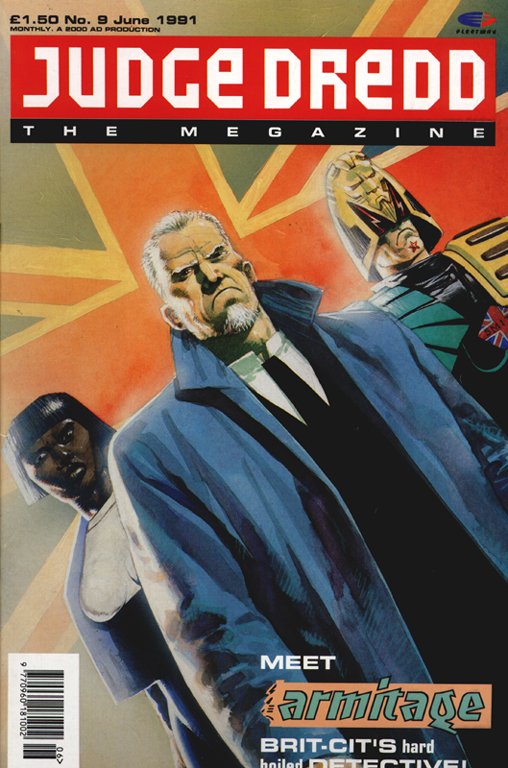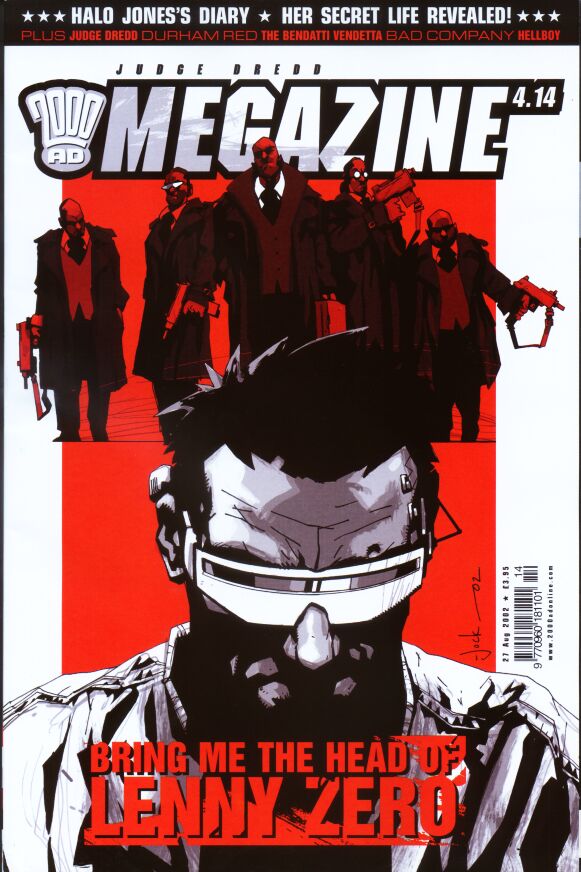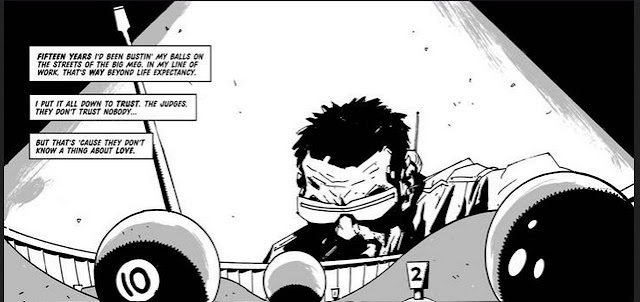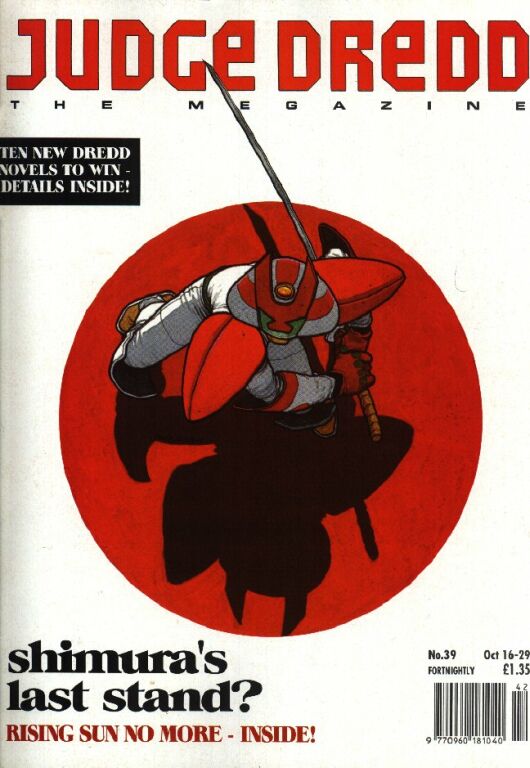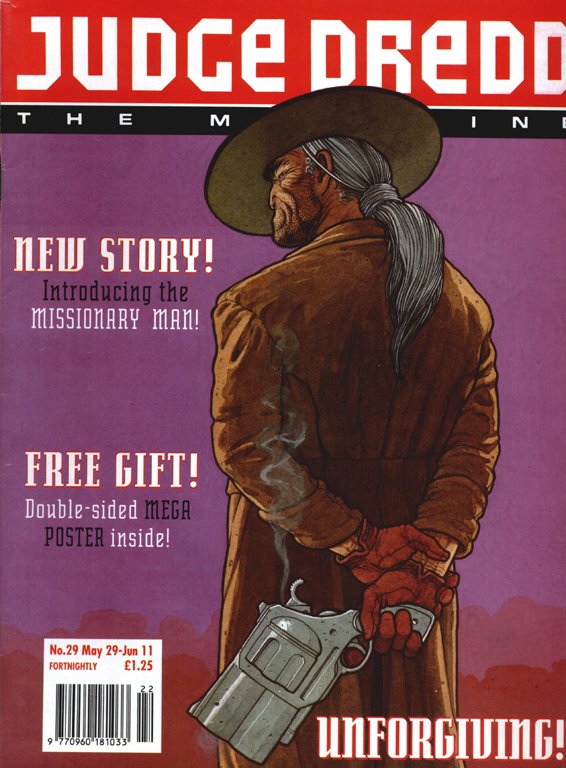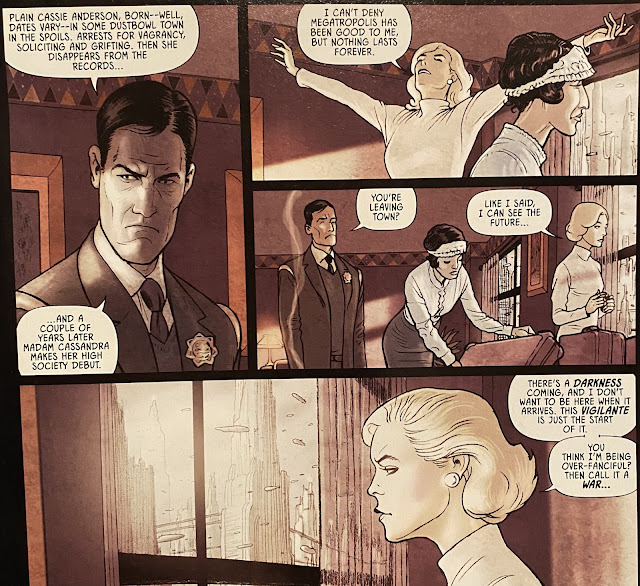Look, the words are good too, but my gosh these are gorgeous comics to behold.
9. Angelic by Gordon Rennie and Lee Carter
(Just 12 episodes across 3 series so far, Megs 356-359, 377-380, 434-437 – but there
may be more to come? Please?)*
What was this? The one where we get to witness the
coming together of the Angel Gang – but a very different Angel Gang to the one
first introduced in the Judge Child saga. It’s more elseworlds, in other words!
But SO GOOD.
 |
| Old man with a gun... and a child... and a monster Art by Cliff Robinson & Dylan Teague |
For an origin story, it actually leaves quite a lot of mystery around its principal characters. We pretty much meet ‘Pa Angel’ (whose name is certainly neither ‘Pa’ nor ‘Angel’, you understand) out of the blue, with no back story. There’s a strong suggestion that he has some connection to Texas City, and a criminal / prisoner back story. But he’s also tough as nails and generally handy in a fight, managing to outsmart and outfight TC Judges (both corrupt and perhaps straight ones), and just maybe there’s some link to Justice Dept in his own past? (Or maybe I’m mixing that up with our old friend Preacher Cain).
Anyway, he soon ends up taking charge of a very young infant,
and it’s this very straightforward (but for 2000AD/the Meg deeply unusual)
thing that makes him a sympathetic ‘hero’, even as he goes around killing and
murdering. The image of Pa Angel with a rigged-up child-carrier on his back is
an all-timer. It looks cool, it makes HIM look cool, it brings with it an air
of mystery, and yes, I suppose it calls to mind Lone Wolf & Cub,
that famous comic about a fightin’ man who goes around with a baby (not his
own) dealing death.
 |
| LOOK AT IT! So much storytelling in one image, that background, those faces, the poses, all of it. Words by Rennie; Art by Carter |
Now, I’ve not read much Lone Wolf, but I’m willing to bet is
has a very different feel to this. Yes, there’s a similarity, but the
differences are pretty stark, and they surely start with the art. Man it’s
great. Carter has a real facility with giving his characters a craggy, hangdog
look, but also a glint in their eyes. He makes ‘Pa’ a noble figure, but also
one with hate in his heart. As the story moves on, his redesigns for Fink and
especially Mean are just super gnarly, but with that hint of sympathy that the
story wants you to feel. And yes, it’s in full colour, set in a movie-esque Western
background, and in that regard could not be more (physically) different to black
and white feudal Japanese countryside. And most of all, to my eyes, the story
and art combine to get readers to look inside the hearts of these strange,
violent people. Unlike the Angel gang of old, they’re not thieves and bullies
and torturers – they’re just people who have seen and lived enough horribleness
that they are willing to do violent things to preserve whatever independence
and I guess love they can cling on to.
Let’s be clear, these are not ‘nice’ people. Pa, though, has this insane sense of right and wrong, and of doing right by people – especially those he empathises with. He will do anything in pursuit of what he feels is correct, which ends up being ‘looking out for people’. It’s never made entirely clear WHY he latches onto the babies and loners and weirdoes he comes across, except that he can se something of his own past in them, I think? Like, they’ve all been abandoned, or mistreated, or pushed around, and he is NOT having that.
And yes, there are hints of an alternative Owen Krysler in
the background, I can’t wait for the story to unfold as he comes on the scene…
Dreddworld relevance? Well, there’s nothing to say
this couldn’t be the same world as Judge Dredd, and I suppose it’s possible
that ‘our’ Dredd could one day encounter this incarnation of the Angel Gang,
either in the present or as some sort of alternate/flashback situation. But let’s
go ahead and just say ‘none – it’s a reimagining of a fun part of Dredd lore’.
Writing: 9.5/10 It’s that man Gordon Rennie again!
For me, this is his single best sustained series. Sure, he’s working with characters
that existed before, but what he does with them is SO different, and SO MUCH
its own thing, that I’m giving it this high praise.
Art: 10/10 Carter is getting even higher praise here – it is both my sort
of thing, and flawlessly executed.
Impact: 6/10 It has only had three series so far (fingers crossed for
more!), but for my tastes it has definitively proved that one CAN do this sort
of alterni-Dredd type stuff and come up with a winner
Overall score: 25.5 / 30
Has it been reprinted? It has not. I guess it’s still
too recent, and with not quite enough episodes, to merit a collection. WOULD
BUY.
*OK, look, confession time. I DID originally include the Angel Gang / Fink series by Si Spurrier and Steve Roberts in my ranking, but somehow I misplaced the write-up and by the time I noticed I was way too high up the list to slot it in. Those two stories are real fun! It’s among my favourite Steve Roberts artwork! But that version of the Angel gang is in the Top 20-30 range, not Top 10.
Anyway, speaking of Si Spurrier…
8. The Simping Detective by Si Spurrier and Frazer
Irving
(8 stories covering most issues between Megs 220-257 (and not counting the one
series in 2000AD)
What was this? The one about a Wally Squad Judge who’s
dressed as a clown, or more specifically, a simp. Perhaps even more notable
than that, the art, dialogue, plotting and generally atmosphere is designed to
evoke film noir trappings*, even as it typically leans into the weirder Sci-Fi concepts
of Judge Dredd’s world. You know, like aliens.
 |
| It's black and white, AND in colour, both at the same time. Neat trick. Art by Frazer Irving |
Look, there’s no getting around the fact that the instant you open a page of Simping Detective, it is IN YOUR FACE. The art is super arresting, a fully painted, mostly black-and-white cacophony of imagery, with rounded faces and limbs but also horizontal lines here there and everywhere, like the whole thing is ‘filmed’ through Venetian blinds.
And the words, my GOD the words, they too are a cacophony of
Chandlerisms and wordplay and drawing attention to themselves and just general ‘look
at ME’ neediness. Except, you know, actually good? Spurrier is an acquired,
shouty taste, but hen it matches the material it really is a delight, although
personally I handle it better in small, episodic doses rather than consumed in
one big collection-sized gulp.
Irving, it seems, was inspired to try matching Spurrier on
the attention-grabbing front, but somehow he’s classier?
None of this really tells you anything about the plots of
these stories, and perhaps that’s no bad thing. It’s classic Wally Squad stuff –
getting in trouble with gangsters, corrupt Judges and straight Judges who may
or may not know who Jack Point is. This stuff I can take or leave.
The plotting IS actively good, I think, when it follows the
template of ‘Point gets into a scrape, how the heck will he get out of it, OH,
look, it’s a combination of careful planning, luck, and help from friends/pet
aliens/love interests.’ Spurrier puts the work in to contrive absurd situations
and unexpected solutions, and this is a skill I admire in a writer. (Very much
the sort of thing John Wagner does better than most anybody else, a great model
to follow!)
 |
| The set, the joke, the punchline - comics style. Words by Spurrier; Art by Irving |
So yeah, you’ve got plotty plots, wordy dialogue, and beautiful cartooning. It’s a lot of flavours mixed together that I can imagine putting people off – and honestly it did start to wear thin – but in its best form, it’s absolutely, deliriously glorious.
Dreddworld relevance? It’s set in Mega City One, our
hero is a Judge, and Dredd himself plus various supporting characters, all show
up.
Writing: 8/10
Art: 10/10
Impact: 8/10 This story went from a one-off idea to an instant series to a
2000AD spin-off to, frankly, something that was so well done and so well
received, the creators kind of had to stop doing it to do other, more lucrative
interesting things.
Overall score: 26 / 30
Has it been reprinted? It has! And it's also in The Mega Collection Vol 21: The Simping Detective, along with the earliest solo incarnation of DeMarco, PI.
*Fun fact! This story began life as an entry into a ‘series’
labelled Mega City Noir, which included one other forgotten one-off
story, but also, much later, Megatropolis.
7. Cursed Earth Koburn by Gordon Rennie (mostly) and
Carlos Ezquerra
(6 stories that ran occasionally between Megs 221 and 396, not counting the
original Judge Dredd two-parter)
What was this? Technically a spin-off from a Judge
Dredd two-parter, but one of those where you just KNEW the character had legs
and didn’t need Dredd around to carry off his own adventures. Anyway, it’s the
one that takes a classic Carlos Ezquerra character type – someone who looks a
bit like James Coburn, is absurdly laconic and cool with it, a bit of a rebel,
but also hyper competent. I guess Major Eazy from Battle is the most direct
ancestor, but I never read that so there may well be other character types who
informed Koburn?
 |
| He's doesn't actually look like James Coburn, but he doesn't NOT look like him, ya know? Art by Carlos Ezquerra |
Minus that comics-world backstory, what this actually is is the adventures of a Mega City Judge who has chosen (I think?) to be posted in the Cursed Earth – the part of it where there are towns of people living in relative safety compared to the really ‘Cursed’ bits. He is a good solid Judge who also hates the whole ‘Judges must live like monks’ attitude that rules in the big city. So it’s amusing that HE ends up being the Judge who has to take on duties looking after city Judges who have screwed up in some fashion or other, as if he’s an ideal role model to put them straight,
Comedy right there.
Of course, he actually IS a great role model, by being good
at his job despite all the lackadaisical attitude and vanity over his clothing
and vehicle choice and so on.
Advanced level comedy. That Rennie, he is an excellent
comics craftsman.
 |
| How to establish character, setting and tone in four quick panels. Words by Rennie; Art by Ezquerra |
So yeah, you’ve got this cool guy in the desert helping
solve crimes and beat baddies and generally be cool while doing it. I suppose
you could argue that, apart from Koburn generally existing to poke holes at the
absurd idea that the Judges can only be ‘good’ if they are super rigid, the series
is not exactly about anything. But then, why should it be? The mutants and ghosts
and bad guys that populate the Cursed Earth inherently give each story a taste
of showing what this crazy future hell on Earth might actually be like. Lots of ghosts...
 |
| That's Rico, that is. Words by McConville; Art by Ezquerra |
And yes, it’s all drawn by Carlos ‘King’ Ezquerra, so the unfolding of each plot is just an invisible masterclass in scene and character set-ups and clear action beats and grand excitement. Shockingly, this was super popular, and it’s a shame we couldn’t get more of it. But, you know, Carlos had other stuff to do as well, and then of course he wasn’t available to work ever again, and we all cried. Some of us still are.
Dreddworld relevance? It's set in the Cursed Earth,
starring Judges, including a Dredd, and everyone’s favourite killer fungus, to boot.
Writing: 9/10 (No slight on my part to Rory McConville,
who wrote the final story. To my mind, he’s also an excellent comics craftsman
who knows how to identify and follow the basic template of a story).
Art: 10/10
Impact: 7/10 Despite only having 21 episodes in total, this character
clearly has legs, and Koburn has shown up from time to time in various
Dredd-related crossovers. Might another artist take over on a solo series? I rather
doubt there’s quite enough appetite, but you never know.
Overall score: 26 / 30
Has it been reprinted? It has - nearly. All but one of the Rennie-scripted tales is in the Judge Dredd: Carlos Ezquerra collection. All but the final McConville-scripted tale in the Mega Collection Vol 67: Cursed Earth Koburn. Justice for Rory!

